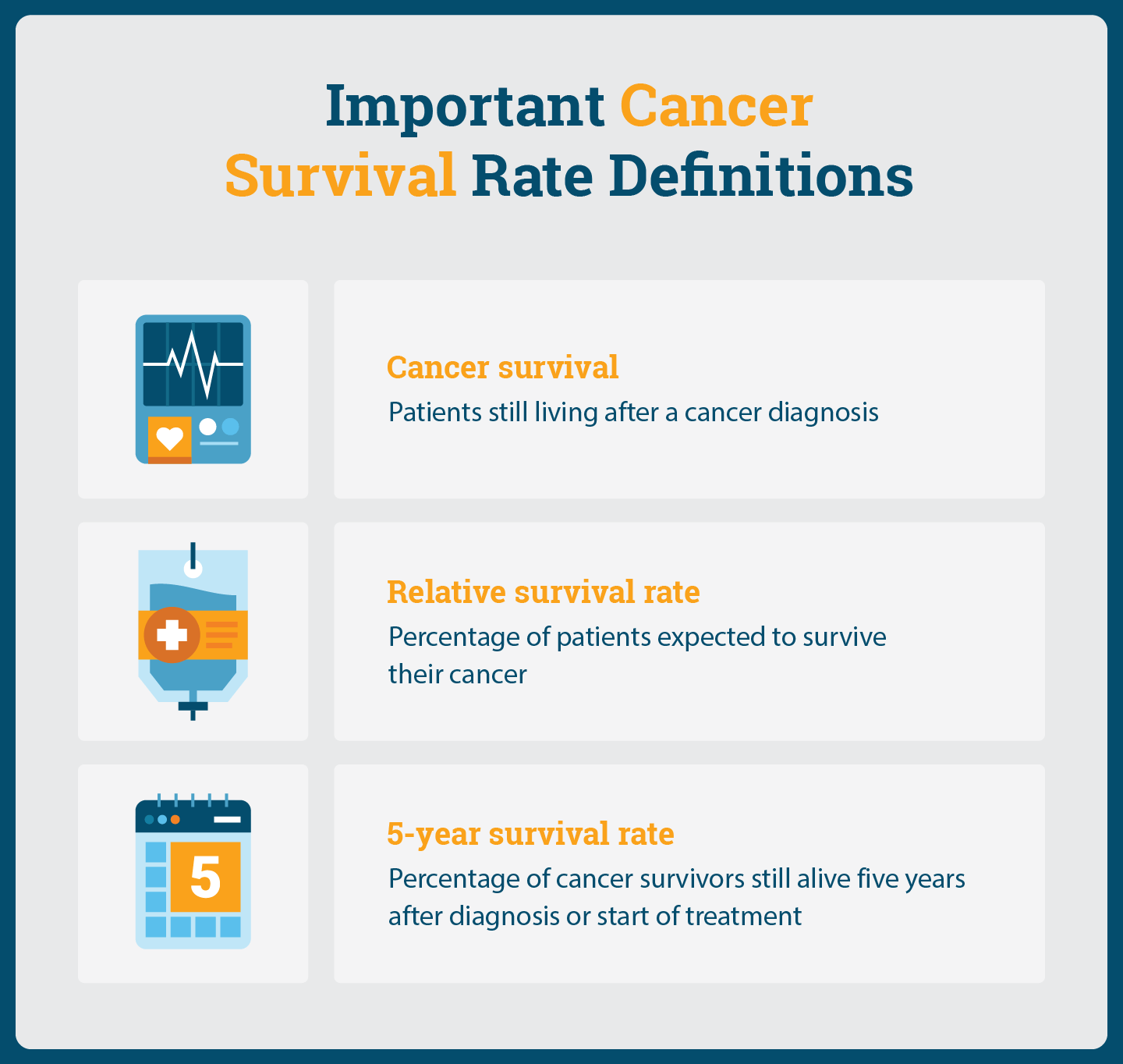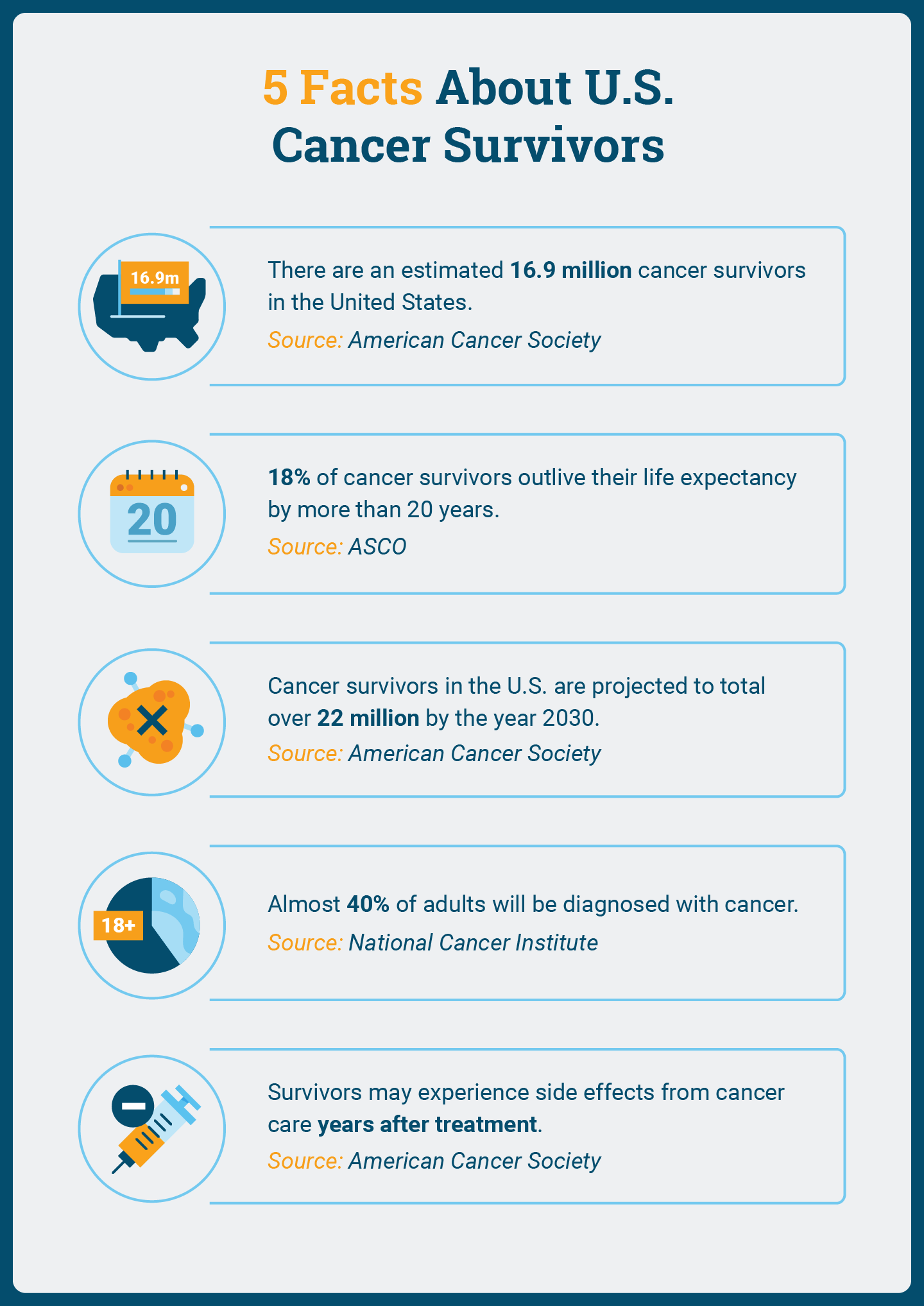Understanding Cancer Survival Rates and Statistics
Written by Sean Marchese, MS, RN | Edited By Walter Pacheco
A cancer diagnosis can often bring fear, sadness and confusion. Patients may wonder what it means in terms of survival. Doctors cannot predict exact life expectancies for cancer patients, but they can use statistical records of cancer survival to provide rough estimates based on previous patients.
Survival rates are one of the key measurements used to track the impact of cancer treatments and services. They can reflect the effectiveness of cancer detection practices and how quickly patients receive access to treatment.
Here we will explore the current cancer survival rates for various types of cancer, as well as the rates defined by age and time since diagnosis. These numbers and additional related statistics can help inform a patient’s cancer journey and assist them in conversations with medical professionals.
Defining What Cancer Survival Means

Cancer survival rates are determined by the number of cancer patients still alive after a period of time following their diagnosis. Rates are typically defined in terms of “relative survival.” This measures the life expectancy among cancer patients as a percentage, comparing the ratio of living cancer patients to the overall population with the same demographics, such as gender, age and race. Survival rates can vary considerably based on a patient’s age at diagnosis and their cancer type and stage.
Some researchers also examine “conditional relative survival rates,” which estimate the probability of the person living an additional number of years given that the patient has already survived a certain number of years since their initial diagnosis. These rates often increase much faster than relative survival rates since those who survive the first few years after diagnosis have higher chances of surviving subsequent years.
5-Year Relative Survival Rates
Cancer survival rates can be calculated for any length of time, but medical researchers typically provide cancer statistics with a 5-year relative survival rate. That rate equals the percentage of people projected to be alive five years after their initial diagnosis. It excludes patients who may die from other diseases.
Cancer Survival Rates Require Perspective
While relative survival offers an indication of the average experience of cancer patients, it is not absolute. Since current annual numbers are calculated based on patients diagnosed in years past, they do not always reflect the impact of recent advancements in cancer treatments and detection methods.
These broadly representative statistics also don’t take into account numerous factors that influence each patient’s survival. These can include external factors such as access to healthy food, safe housing and treatment, and biological factors such as a family history of cancer.
U.S. 5-Year Cancer Survival Rates
Thanks to advancements in cancer treatment and an increase in earlier diagnoses of many cancers, the 5-year relative survival rate for a combination of all cancers tracked since the early 1970s has increased from 49% to 68%.
What Is Your Likelihood to Survive Cancer?
U.S. 5-year cancer survival rates provide projections
Hover over the data below to reveal percentages
Source: National Cancer Institute, 2022
Thyroid cancer currently has the highest 5-year survival rate at 98.4%. Two cancers that affect men also feature high 5-year survival rates, with prostate cancer ranked second highest at 96.8% and testicular cancer coming in third with 95%.
According to the National Cancer Institute, four of the five cancers with the best 5-year survival rates are also among the most common cancers in America. Breast cancer is the country’s most commonly diagnosed cancer. It has a relative 5-year survival rate of 90.6%.
| Thyroid | 98.4% |
| Prostate | 96.8% |
| Testicular | 95% |
| Skin Melanoma | 93.7% |
| Breast | 90.6% |
Two cancers with the lowest 5-year survival rates are pancreatic cancer at 11.5% and mesothelioma at 11.7%. Mesothelioma is a rare cancer caused by asbestos exposure. It can develop in the lining of the lungs, abdomen, heart or testes. Asbestos exposure can occur in a variety of ways, from workplace exposures to environmental exposures.
The cancers ranking third through fifth for the lowest 5-year survival rates are gallbladder, esophageal and liver cancer, with rates of 20.4%, 20.6% and 20.8% respectively. That’s almost double the 5-year survival rates of pancreatic cancer and mesothelioma.
| Pancreatic | 11.5% |
| Mesothelioma | 11.7% |
| Gallbladder | 20.4% |
| Esophageal | 20.6% |
| Liver | 20.8% |
Cancer Survival by Years Since Diagnosis
How Years Since Diagnosis Affects Cancer Survival
U.S. 5-year cancer survival rates provide projections
Hover over the data below to reveal percentages
Source: National Cancer Institute, 2022
Projections of cancer survival for some cancers, such as pancreatic cancer, increase the further a survivor gets from their initial diagnosis. Someone still living five years post-diagnosis can have a higher overall rate of survival than someone who is only one-year post-diagnosis.
In some instances, those few years of difference can reveal a drastic increase in survivability if a patient lives for five or more years after diagnosis. The most drastic examples of this are seen in two specific cancers where the survival rate almost triples between year one and year five of survival.
Statistics on mesothelioma show that patients are given an 18.9% survival rate after one year, but that number climbs to 56.2% after five years. Pancreatic cancer patients start out with a 26.1% chance of survival after one year, which grows to 71.4% after five years.
Cancer Survival by Age
Does Age at Diagnosis Impact Cancer Survival?
U.S. 5-year conditional relative cancer survival rates provide projections
Hover over the data below to reveal percentages
Source: National Cancer Institute, 2022
When we shift to look at 5-year conditional survival rates, young people have a greater likelihood of surviving most cancers, with an average rate of 94.9% among those ages 0-44 who have already survived the first five years post-diagnosis. The 5-year conditional relative survival rate decreases as the age at diagnosis increases — 93.4% for those 45-54 years old, 93% for ages 55-64, and 90.2% for adults 65 and older.
When looking at specific cancers, the most drastic shift in 5-year conditional relative survival rates based on the age at diagnosis is seen among mesothelioma patients. Since mesothelioma typically takes between 20 and 60 years to develop after exposure to asbestos, it is rare for younger adults to receive the diagnosis.
The average 5-year conditional relative survival rate for people ages 0-44 who were diagnosed with mesothelioma is 84.3%. These rates decrease for older adults. People ages 45-54 have a 5-year conditional relative survival rate of 65.3%, while those 55-64 have a 52.8% 5-year conditional relative survival rate. Adults over age 65 have a 5-year conditional relative survival rate of 40.9%, the lowest rate for any age group by any cancer type.
Cancer Survival Statistics
Statistical data on cancer survivorship is an important tool for medical professionals caring for their patients. Doctors often use 5-year survival rates to provide patients with a prognosis and to help evaluate potential treatment options.

Other useful data tracked by researchers about cancer survivors reveal:
- The U.S. is home to more than 16.9 million cancer survivors, representing 5% of the country’s population.
- Approximately 18% of cancer survivors have survived their diagnosis by 20 years or more.
- The American Cancer Society estimates the number of survivors will grow to more than 22.1 million by 2030 as a result of population growth and an increase in the country’s aging population.
- According to the National Cancer Institute, about 39.5% of adults will receive a cancer diagnosis.
- Some survivors experience side effects of their cancer treatments months or even years later.
Cancer Survival Stories
Cancer survivorship is visible across all demographic lines, whether they be gender, age, occupation, location, etc. And each cancer survivor’s story provides inspiration. Some patients choose standard cancer therapies, while others opt for aggressive treatments such as intensive surgery or experimental methods offered through clinical trials.
Tina Herford is a survivor of multiple cancers, including breast cancer and two types of mesothelioma. When faced with a pleural mesothelioma diagnosis in 2016 and then a peritoneal mesothelioma diagnosis in 2017, she chose to undergo aggressive and lengthy surgeries to treat each one. Although her recovery process had some challenges, she has gone on to thrive in the years since.
Cervical cancer survivor Tamika opted for a grueling balance of treatments, including surgery to remove her uterus and cervix followed by chemotherapy and radiation therapy. While she faced side effects during treatment and mental health challenges afterward, she used her experience to start the nonprofit Cervivor to support other cervical cancer survivors.
Cancer survival rates do not provide a promise of recovery, but they can offer a sense of perspective – and often hope – that newly diagnosed patients need early in their cancer journey. Survival rates are not perfect in the probabilities they relay, but they are a useful measurement to gauge life expectancy and the success of evolving cancer care.






